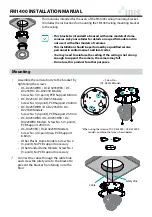
Operating manual for caravan-charging system CSV 410
12
Date: 20.02.2020
8050102 BA / EN
6 Technical details
6.1 Mechanical details
111 x 320 x 217 (H x W x D in mm), including attachment feet
2 kg
PA (polyamide), gentian blue (RAL 5010)
6.2 Electrical details
230V AC
10%, 47 -- 63 Hz sinusoidal, protection class I
3.2 A
6-cell lead acid or lead gel batteries, 80 Ah and above
Without control and switch panel: 0 mA, plus consumption of refrigerator
control electronics;
With control and switch panel (e.g. LT310/LT409): approx. 2 -- 3 mA, plus
consumption of controller electronics of refrigerator
Conditions for the measurement:
F
Approx. 10 minutes after mains isolation without mains connection
F
12.6V battery voltage
F
Battery alarm OFF
F
All consumers switched off
F
12V main switch off
12V outputs
A maximum of 90% of the nominal cur-
rent
of the relevant fuse may be
drawn.
Caravan battery
Charging curve
IUoU
Final charging voltage
14.4 V
Charge current
28 A in the entire mains voltage range,
electronically limited, minus the
charge current into the towing vehicle bat-
tery
Voltage for float charge
13.7 V with automatic switchover
New charge cycle,
with battery voltage below 13.7 V
Switchover to main charging
with approx. 5 seconds delay
Main charge
I
Full charge
Uo
Trickle charge
U
4 h for lead--acid
16 h for lead--gel
Time
14.4
13.7
U
charge
V
Fig. 4
Example of the charge voltage behaviour with the CSV 409 A caravan charging sy-
stem
Dimensions
Weight
Casing
Mains connection
Current consumption
Suitable batteries
Standby current from
Caravan battery
Current--carrying
capacity
Battery charging via
mains connector


































